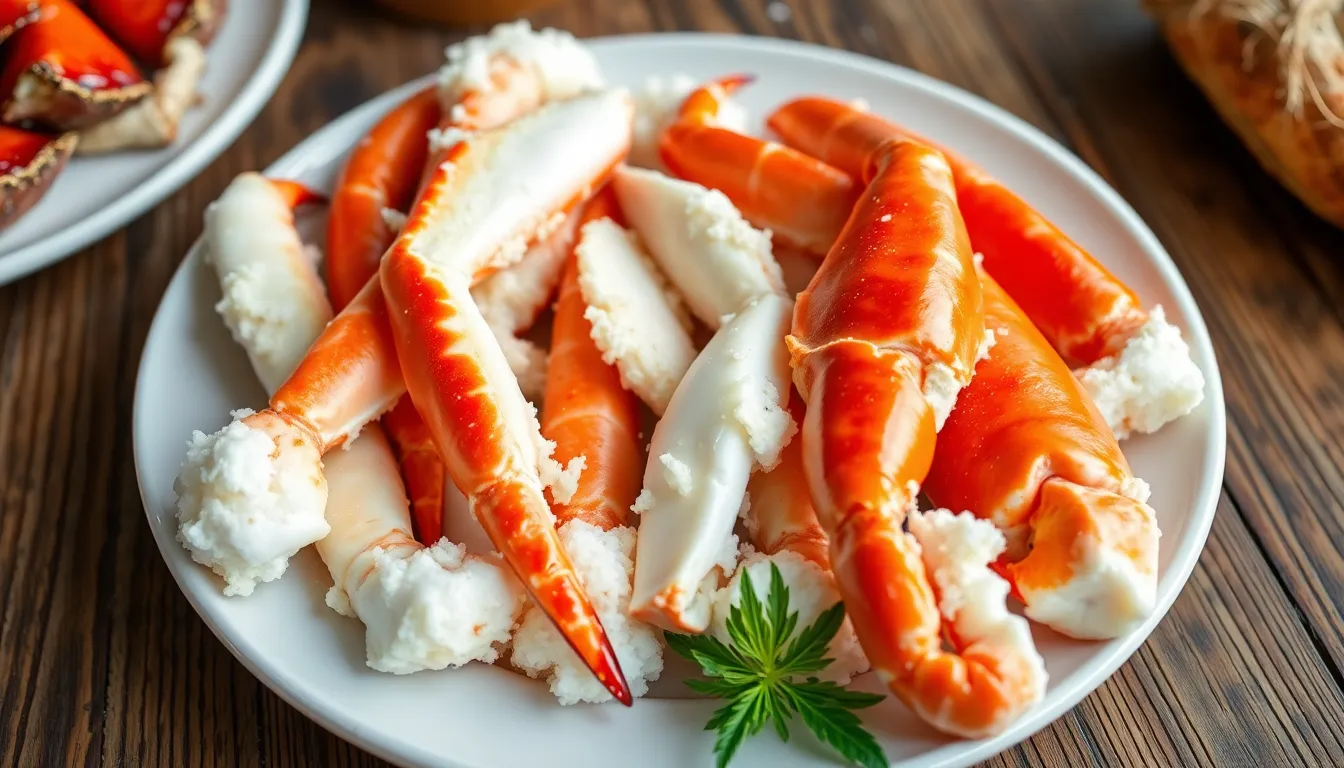When it comes to seafood royalty, two contenders reign supreme: snow crab legs and king crab legs. Both promise a feast for the senses, but which one truly deserves the crown? Imagine sinking your teeth into tender, succulent meat that dances on your palate like a ballerina at a seafood gala. It’s a delicious dilemma that has seafood lovers debating like it’s the ultimate showdown.
Table of Contents
ToggleOverview Of Snow Crab Legs And King Crab Legs
Snow crab legs and king crab legs represent two distinct types of preferred seafood. Snow crab legs come from the Chionoecetes species and are known for their sweet, delicate flavor. Meanwhile, king crab legs, sourced from the Paralithodes genus, are celebrated for their rich, succulent taste.
Snow crab legs typically feature a thinner shell, making them easier to crack open. Their flesh is tender but boasts a firm texture. King crab legs, by contrast, present a thicker shell requiring more effort to break. The meat inside is dense and often more flavorful due to higher fat content.
In terms of size, king crab legs dominate, measuring up to 10 inches in diameter. They tend to be more substantial and yield more meat per leg. Snow crab legs, while smaller, still deliver a satisfying portion at around 5 to 7 inches in size.
When analyzing nutritional content, both types are low in fat and high in protein. Snow crabs provide about 19 grams of protein per 3-ounce serving, whereas king crabs offer approximately 23 grams for the same portion. Sodium levels can differ, with king crabs generally having slightly higher levels.
Availability varies seasonally. Snow crabs are usually caught in the spring and early summer. King crabs, however, are often harvested in the fall and winter months. Price points reflect demand and availability, with king crab legs commanding higher prices due to their size and exclusivity.
Culinary uses for both types of crab legs are versatile. Chefs often serve them steamed, boiled, or grilled, enhancing their flavors with butter and herbs. In essence, the choice between snow crab legs and king crab legs hinges on personal preference, occasion, and culinary creativity.
Taste And Texture Comparison

Snow crab legs offer a sweet, delicate flavor which seafood enthusiasts often appreciate. Their tender meat features a light, flaky texture that pairs well with various dipping sauces. Easier to crack open, these legs allow for quick access to the meat and enhance the dining experience. Chefs enjoy using snow crab legs in salads, pasta dishes, and soups due to their mild taste, making them versatile for many cuisines.
King crab legs, on the other hand, provide a rich, succulent flavor that distinguishes them from their snow crab counterparts. Known for their firm and meaty texture, king crab legs yield a satisfying bite. Larger and thicker, these legs require more effort to open but reward diners with more meat per serving. Many prefer king crab legs in butter or garlic sauce, as their robust flavor stands up well to bold seasonings.
Nutritional Value
Both snow crab legs and king crab legs offer impressive nutritional benefits, making them popular choices among seafood lovers. Each type of crab delivers a rich source of protein along with various other essential nutrients.
Protein Content
Snow crab legs contain about 19 grams of protein per 3-ounce serving. In comparison, king crab legs provide approximately 24 grams of protein in the same serving size. This higher protein content in king crab legs contributes to their reputation for being more satisfying, especially when served as a main dish.
Other Nutrients
Snow crab legs are low in calories, containing around 80 calories per 3-ounce serving. King crab legs, on the other hand, have about 110 calories per the same serving size. Both options are also rich in minerals like zinc and selenium, essential for immune function and metabolism. Snow crab contains slightly more omega-3 fatty acids, beneficial for heart health, while king crab legs provide a higher concentration of vitamin B12, crucial for nerve function and energy production.
Cooking Methods
Different cooking methods enhance the flavors of snow crab legs and king crab legs. Each offers unique preparation techniques.
Preparing Snow Crab Legs
Steaming snow crab legs claims a popular method, retaining their natural sweetness. Boiling also works well, taking about 4 to 5 minutes for pre-cooked legs. Seasoning options like Old Bay seasoning or a splash of lemon juice adds extra flavor. Short, simple steps make it easy to prepare; thawing legs in cold water before cooking speeds up the process. Serving with melted butter or a garlic dipping sauce enhances the experience.
Preparing King Crab Legs
Boiling king crab legs ensures a tender, juicy result, with a cooking time of 6 to 8 minutes for pre-cooked varieties. Steaming also prevails, with flavors deepening as the meat cooks through. Adding herbs or spices to the boiling water introduces additional zest. Remove the legs from the water and deliver straight to the table for a fresh, vibrant presentation. Dipping them in melted butter accentuates their rich flavor, enhancing the overall dining experience.
Pricing And Availability
Snow crab legs and king crab legs differ significantly in pricing. Snow crab legs typically cost between $20 and $30 per pound, reflecting their moderate demand and seasonal availability. In contrast, king crab legs price ranges from $40 to over $70 per pound, resulting from their larger size and higher demand during peak shopping seasons.
Availability varies by season and geography. Snow crabs are primarily harvested in spring and early summer. King crabs are caught in fall and winter, limiting their fresh options for most of the year. Markets often stock snow crab legs more consistently, while king crab legs appear sporadically, especially around holidays or special occasions when demand surges.
Regional factors influence both types of crab legs’ pricing. Local markets along coastal areas may offer lower prices due to fresher inventories and direct supply. Online retailers sometimes provide competitive pricing but can include shipping costs that impact the overall expense.
Consumer preferences also play a role in pricing fluctuations. As more people seek nutritious, gourmet options, both types of crab legs can experience increased prices during peak times, like holidays or festive periods. Specials or promotions may occasionally reduce prices, making it easier for buyers to enjoy these seafood delicacies.
Established suppliers often facilitate access to these crab legs. Retailers with strong connections to seafood distributors ensure consumers find quality products throughout the year. Hefty demand signifies that prices may change rapidly, so staying informed proves vital for crab leg aficionados. This climate creates a dynamic market where timing and sourcing become key to securing the best options at favorable prices.
Choosing between snow crab legs and king crab legs ultimately comes down to personal taste and occasion. Snow crab legs offer a sweet and delicate flavor with easy access to tender meat, making them ideal for lighter dishes. King crab legs, on the other hand, deliver a rich, meaty experience that stands up to bold flavors and larger servings.
Both options provide impressive nutritional benefits and can be prepared in various ways to enhance their unique qualities. Whether it’s a casual gathering or a special celebration, each type of crab leg brings something special to the table. The decision may vary based on availability and budget but enjoying either will surely elevate any seafood feast.


